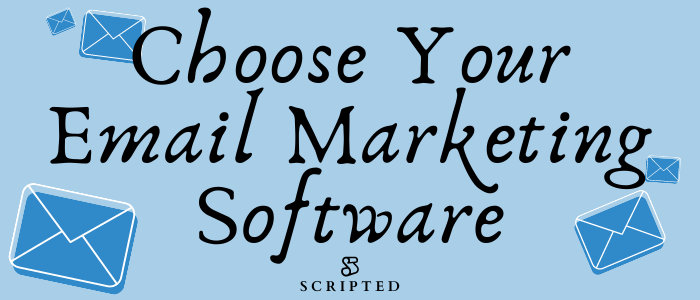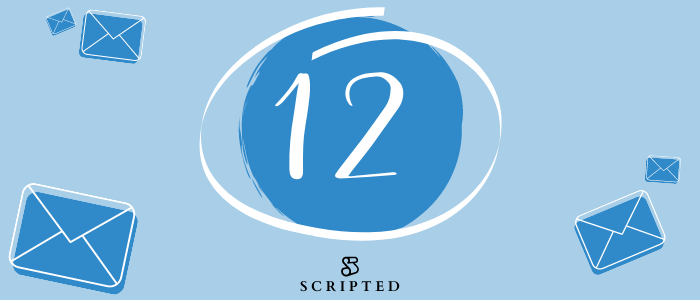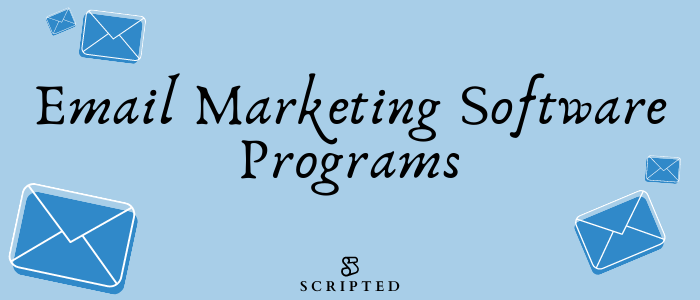- Blog Home
- Ciara Antolini
- Choose Your Email Marketing Software
Choose Your Email Marketing Software

Is email dead?
If you’re a marketer in the fast-paced digital marketing landscape, you must have come across arguments against email marketing. But the numbers tell a different story, and as a marketer, you understand and appreciate the power of numbers!
Today, 64% of small businesses utilize email marketing, and 77% of marketing professionals state that email engagement is increasing, according to HubSpot. From individuals to businesses and public offices, email has a broad reach across different audiences.
Email is a versatile tool that can help with tasks including but not limited to:
- Lead generation
- Sales
- Brand trust
- Audience understanding
- Cross-device promotions
- Targeted marketing
- Engagement tracking
Using email marketing software is the most effective strategy to harness the power of email. With reliable email marketing software, you get a multitude of features to unlock your campaigns. Some of the most notable features include automation, personalization, segmentation, editing, reporting, and analytics.
12 Steps to Choose the Right Email Marketing Software
![]()
If you want to unlock your email marketing campaign, find the most suitable email marketing software for your company. This guide explores some factors to consider when choosing an email marketing platform. If you need email marketing content right away, you can sign up for a free account with Scripted. It takes a few seconds to register, and you gain instant access to AI (artificial intelligence) powered email sequences including but not limited to:
- Press releases
- New product launch emails
- Company updates, e.g., mergers and acquisitions
- Vendor, supplier, or client newsletters
- Lead generation email sequences
- New customer onboarding emails
- Post-purchase support
Scripted Copilot, Scripted’s AI assistant, can take information from your brand and style guide as well as details you input to create content that you can use instantly. Plus, there’s always the option to upgrade and gain access to Scripted’s highly respected pool of subject matter experts (SMEs) from across multiple industries.
1. Evaluate Your Email Marketing Needs
![]()
Before you start the search for email marketing software, brainstorm with your marketing team and discover what you want from this type of tool. Different email platforms offer unique features and advantages suited for specific businesses or industries.
If you have an email strategy in place, review your objectives and narrow down the email marketing tools that suit your needs. Some email tools work best for segmentation and personalization, while others are better for targeted marketing.
If you already have an email list, for instance, the next step to grow your sales would be to find an email tool that helps with lead generation. If you have no contact list, your needs are different, and you’ll want email software that can help you build or manage a contact list. If you have an e-commerce store, the best email marketing software should allow for integration with e-commerce platforms like Shopify.
Related reading: Which E-commerce Platform Should I Use?
Assessment of your marketing needs eases the shopping process for email marketing software, offering a checklist of the goals you want your email marketing platform to achieve. The needs assessment process helps you get more value out of the tool you eventually purchase.
2. Look for Software With a Drag-and-Drop Builder and Templates
![]()
One of the most important email tools you can get is a drag-and-drop builder to create templates you can use again and again. The best email template builder should allow you to create and use advanced branded email templates with little to no coding experience.
When you choose email marketing software, make sure you can easily drag and drop images and other content to create a personalized email. An email builder delivers a responsive email on any device, has a better engagement rate for emails, and improves efficiency in your email creation process.
A good email platform offers a diverse range of pre-built and mobile-ready templates to start you off. The builder tool should have intuitive editing features, the ability to edit layouts and content, and preview your messages before you hit "send." Finally, it should also offer future scheduling capabilities for the emails you don't need to send immediately.
3. Check Sign-up Forms and List Growth Opportunities

If you want to leverage email marketing for your brand, you can grow a relevant contact list early on with quality sign-up forms.
Sign-up forms collect email addresses from potential leads and customers. Forms are a powerful tool in your marketing campaign, and the best email marketing software offers an optimized sign-up form design.
There are multiple form designs to choose from, including inline, pop-up, time-delayed pop-up, scroll-delayed pop-up, exit-intent pop-up, and two-step pop-up forms, among others. Look for a platform with native sign-up forms so you can reach more people through more email subscriptions.
4. Evaluate Segmentation and Personalization Capacity

To use email for your marketing campaigns, start by narrowing down your target audience. The best email marketing software offers targeted marketing through innovative segmentation and personalization features.
You might have a broad list of email contacts, but without segmentation, your marketing campaigns won’t deliver the expected outcomes. Ignoring segmentation essentially means you’re trying to market to everyone, which just ends up being a waste of resources. Through segmentation, you can launch hyper-targeted campaigns with relevant content rather than spreading your marketing efforts too thin.
The best email marketing software allows you to group your contacts by:
- Gender
- Age
- Preferences
- Past shopping experience
- Amounts spent
- Website behavior
- Email engagement
- Geographical area
- Position in the sales funnel
- VIP segmentation
Through segmentation, you can now personalize your emails and enjoy higher ROI, better engagement, increased revenues, stronger relationships, lighter workload through automation, and other benefits.
5. Check for Apps and Integrations

The digital landscape has grown fast, and there’s a diverse range of solutions you can integrate into your email campaigns to boost performance. Email can only achieve so much on its own, but with integrations, you boost its capabilities and optimize your campaigns.
Some of these integrated tools help with content and image editing, marketing, customer relationship management, data analysis, tracking and analytics, and so much more. The more apps you can integrate into your email marketing software, the better for your campaigns.
For example, your customer relationship management (CRM) system can plug straight into your email generation software to ensure each email is completely personalized and goes to the right address. This changes introductions from “To whom it may concern” or “Dear CEO” to “Hi Sam, Nice to talk to you again.”
You can also look for email software that integrates data from different business sources. For example, if you send a regular newsletter explaining how your business is performing, integration between your performance dashboards and your email software reduces the time spent manually inputting stats and KPIs every time. Plus, it removes or at least greatly reduces the risk of human error.
Effective email integrations streamline communication with your clients and stakeholders while providing more meaningful data to your readers.
6. Consider Reading and Viewing Options

Mobile phones are major emailing devices, and you have to consider this viewing option when designing your emails. This means if you haven’t optimized your email reading and viewing options for mobile, you’re missing an opportunity to reach a steadily growing mobile market.
Over 66% of the world’s population uses a mobile phone, and 84.2% of people in the United States use their phones to go online, according to marketing expert Luisa Zhou. Optimizing your content for smartphones and tablets is no longer a “nice to have.” It’s essential to prevent clients from clicking away and finding a site that’s easier to read while they’re on the train, on their lunch break, or sitting in the back of a cab.
This is just as vital for business-to-business (B2B) marketers as it is for business-to-consumer (B2C). 50% of B2B search queries are now made via a smart device, and that figure is steadily growing.
7. Look at Email Response Handling

How do you respond to thousands of emails from target leads in your marketing campaigns? The quality of email response handling can make or break your efforts. Look for an email marketing platform that allows automation of responses or aggregate customer responses.
Chatbot email technology can also help you respond quickly to incoming email leads. These bots leverage AI to deliver customized email responses. This improves your email response handling and ensures prompt feedback, which is critical in lead generation.
AI-powered automatic responses may use a set response typed by your marketing team. However, generative AI can also help generate more personalized responses. Here’s an example of a standard response:
“Hi, Thanks for reaching out. We just want to let you know we received your email, and a representative will get back to you soon. In the meantime, check out these resources on our website.”
This is a great placeholder but doesn’t necessarily provide any information that’s useful to the querent. If the emailer wanted to know your office opening hours, for example, they might simply go to a competitor that responds to them more quickly.
Generative AI, conversely, utilizes large language modeling (LLM) and natural language processing and generation (NLP and NLG) to figure out an appropriate response. It can take note of the name of the sender and the query and provide relevant information that might keep a dialogue open. There is often the option to add branding and style options to generative AI responses to keep them feeling like they’ve come from a company representative. Here’s an example of a generative AI response using Scripted Copilot, Scripted’s GPT-4 powered AI assistant:
“Hello, Dave!
Just letting you know that our office is open every day of the week from 9am to 6pm. Don't forget, all this info is also available on our website. We are here to help however we can, so don't hesitate to call us at 01234567891 if you need further assistance.
Do you have any other questions regarding our software solutions?”
Both responses used AI, but the generative AI email works with the information provided in the incoming email to create a highly personalized response.
The generative AI market is predicted to grow by over 35% over the next five years. Investing time in learning how AI can benefit your email marketing efforts could boost your ROI significantly. Remember, you can try out Scripted Copilot for yourself and get Scripted’s AI-generated email content completely free of charge right here.
8. Perform A/B Testing

The A/B testing feature helps you determine what’s working by sending emails to a subset of your subscribers. If you choose one of the better email platforms on the market — check out our recommendations below — you can test a variety of features, including message content, subject lines, images, even message length, chatbot/automation functionality, mobile functionality, CTA buttons, the best times to send, and much more.
Send a variation of your email to another subscriber set for varied responses. The goal is to decide which email campaign is best for you. You can make changes based on the review of the test to improve your email design, content, or other features.
Effective A/B testing requires only one element to change each time. This helps marketing professionals understand exactly what’s caused the rise or fall in click-throughs, emails opened, or other forms of engagement. Again, AI is handy here. You can give the generative AI tool a fully-formed email and ask it to change a single element, like the CTA. The AI can provide multiple versions almost instantly. You can then try out each of these versions across different audience segments for incredibly granular data on the effectiveness of different CTAs.
9. Review Deliverability Best Practices

Don’t overlook deliverability as a factor when choosing the best email marketing software. Deliverability means that emails actually arrive in a recipient’s inbox. This requires accurate contact lists, flawless connectivity, and integrations with systems that store customer contact details, e.g., your CRM.
Click-through rates and open rates become meaningless if your customers aren’t even receiving your emails. Great email software should instantly report if there are issues sending emails, which email addresses or contacts are causing the issues, and what to do next.
Do not fall into the trap of being tempted to buy contact lists from third parties. You have no guarantee that consent has been given for third parties to have these contacts, so you put yourself and your organization in murky legal waters by doing this. Some organizations “scrape” email addresses from websites and then sell them to marketers. This is actually illegal in the United States and many other countries, so make sure your deliverability practices are compliant with the law and any state or industry regulations.
A really good email software application should provide advice on how to ensure your email address doesn’t get blocked or blacklisted. This will include advice on formatting, such as avoiding all uppercase letters or multiple exclamation points. It may also include avoiding “over spamming” by keeping emails to essential or requested communication and only sending “cold” emails where appropriate.
10. Evaluate Reporting and Analytics

Choose an email platform that allows concise tracking to determine click-through rates, click-to-open rates (COTR), subscriber value, cost per subscriber, and engagement time. Modern marketing needs to be highly data-driven to implement meaningful changes to your email campaigns and get ahead of your competitors.
Other parameters you might want to record and analyze include:
- Delivery rate
- List growth rate
- Email forwarding rate
- Bounce rate
- Unsubscribe rate
- Overall engagement trends
- Other critical KPIs/parameters
With real-time, reliable data, you can evaluate the success of your email campaign, optimizing performance and achieving continuous improvement. Some email tools may integrate with business intelligence (BI) software to create dashboards and reports that make this data easily digestible for multiple members of your team.
11. Look for Email Marketing Automation

We already touched on automated responses and chatbot technology, but full email marketing automation allows you to send triggered/timed emails to multiple subscribers on your mailing list as needed. The best email marketing software lets you schedule emails and send them at appointed times or triggers a send when certain conditions are met.
12. Find 24/7 Support

When you compare email marketing platforms, don’t overlook the need for round-the-clock support. If you have any hitches, you need the best backup from the software’s provider to guarantee your campaign doesn’t falter.
Our Top Picks of Effective Email Marketing Software Programs

The popularity of email as a marketing tool has seen a proliferation of highly effective email marketing tools. These include:
Mailchimp: One of the most recognizable email marketing software brands, offering multiple features that most businesses need with a marketing approach based on well-designed campaigns and strong data analysis.
ActiveCampaign: A great option for email automation, with pre-built functions in sales, marketing, and support processes for personalized campaigns.
Drip: Ideal email solution for new e-commerce businesses with sophisticated workflows combined with advanced list segmentation and automation.
Constant Contact: Most beginner-friendly email builder with a smart email editor to design professional and aesthetically pleasing emails.
Brevo: Previously SendInBlue, Brevo offers a full customer relationship management (CRM) system, including a fully automated email marketing solution, ideal for growing your contact list.
MailerLite: An intuitive email marketing service and also one of the best free solutions offering a wide range of features and award-winning, live, 24/7 support.
HubSpot: An all-in-one marketing suite and CRM with email automation and automated workflows that help you set triggers for your email subscribers and nurture leads into customers.
Moosend: An AI-powered email marketing and automation solution that includes a drag-and-drop email builder, a segmentation tool, and accurate real-time analytics.
GetResponse: An all-in-one email marketing solution with e-commerce integrations, GetResponse specializes in automation and has an impressive range of features, including autoresponders, webinar software, an audience segmentation tool, landing page builders, automated emails, and advanced analytics — this platform is considered highly affordable.
Choosing the Right Content Tools is Essential
Finding the right email marketing tool to suit your business needs is easy if you start with an assessment of your needs, set clear, measurable goals, and consider the other factors in this list. Once you have the right software, it’s time to consider the content of your emails. Drafting email after email is time-consuming and prone to human error when not performed by an expert.
Thankfully, Scripted’s one-stop platform is on hand to help businesses draft emails that convert leads and drive engagement. Free, AI-powered content is ideal for fast email sequences generated at scale. You even have the paid option of sending any AI content to a human editor for tweaking.
Alternatively, for industry expert insights and thought leadership content, connect with one of our SME writers who can craft as many emails as you need, working to your timescale and brand requirements.
Get all your email content in a single platform with Scripted. Register today for free or schedule a call to arrange a demo.